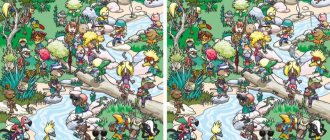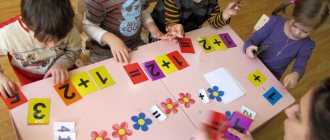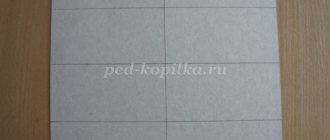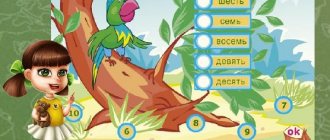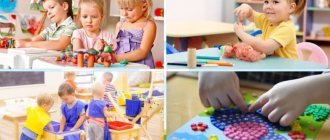Card index “Didactic games for the formation of ideas about the size of objects” in the senior group
Svetlana Dozhirova
Card index “Didactic games for the formation of ideas about the size of objects” in the senior group
Hide the ball in your palms
Goal: To learn to focus on the size of objects , to correlate hand actions with the size of objects .
Equipment: Balls of the same color, but in two contrasting sizes (large and small, tray.
Progress of the game : The teacher places two balls on the table - a large one and a small one. Shows children how to hide a ball in their palm. Then he calls someone and offers to take any of the two balls and hide it in the same way. If the child takes a small ball, he will be able to complete the task, but if he takes a large ball, then the ball remains visible. The teacher says that the ball is not hidden, it is visible because it is big. Then he gives different balls to all the children and asks them to hide them in their palms. The teacher discusses the results of the task with the children. After this, he distributes the balls to the children again, this time giving them a choice .
Hide the toys
Goal: The same, use samples when completing the task.
Equipment: Bunnies, bears (large and small toys, boxes of two sizes according to the number of children.
Progress of the game : The teacher gives the children two boxes with lids (two sizes)
and two toys each - large and small. Asks children to hide toys in boxes and close them with lids. Draws attention to the fact that if the lid does not close, it means that the toy is not suitable for this box - it must be hidden in another, otherwise the wolf will come and see the bunny. This way he encourages children to try.
Drop the ball into the box
Goal: Continue to draw children’s attention to size , make it a significant sign, teach children to try to consolidate their knowledge of the words “big”
,
"small"
.
Equipment: Box with a small round slot, balls (large and small)
one color.
Progress of the game : The teacher puts a box on the table, puts balls next to it and tells the children that now the children will find out which ball will hide in this house. He calls one and offers to push a ball into the hole. The child independently completes the task through trials. When the small balls are hidden in the house, the teacher draws the children’s attention to the fact that the hole in the box is small, only for small objects . There were large balls left on the tray.
Help the bear and the doll
Purpose: Same.
Equipment: A doll and a bear (or a bear and a bunny, etc., geometric figures of different sizes ( two balls, two cubes, two parallelepipeds, boxes with slots corresponding to the contours of the geometric figures.
Progress of the game : The teacher puts two boxes with round slots on the table, places a doll near one box, a bear near the other and says that the doll and the bear were playing together, and now they are terribly upset. They don't know where their balls are. Calls the child and asks him to help the bear and the doll collect the balls in their boxes. If a child puts a small ball into a large hole, then the teacher says that the bear (doll)
there won't be enough toys, he will be very upset. The teacher takes out a small ball and encourages the child to try again, but you just need to be careful: lower the big ball into the large hole, and the small ball into the small hole.
When the child completes the task correctly, the doll and the bear rejoice and thank him.
Then the teacher places boxes with square slots on the table. Other toys arrive, the teacher calls another child. The game repeats itself.
Push the balls (cubes, ovoids, bars)
Goal: The same, learn to correlate planar and volumetric shapes size , trying, discarding incorrect options and fixing the correct ones.
Equipment: Boxes, each with 4-5 holes of the same shape (round, square, rectangular, but of different sizes ; geometric shapes of different sizes , corresponding to the size of the holes .
Progress of the game : The teacher gives the children boxes and geometric shapes and offers to put all the figures into the box - each in its own hole. The teacher goes around the children, watches how they act, asks them to try and shows how to do it.
Each child can repeat the task. Later, children are given boxes with other shapes .
Hide the nesting doll
Goal: To introduce children to the principle of folding a nesting doll (the small one hides in the larger one)
; evoke a positive emotional attitude towards the toy and actions with it.
Equipment: Double nesting dolls according to the number of children, a large double nesting doll for the teacher, a bear.
Progress of the game : The teacher puts a matryoshka doll on the table, examines it with the children, then opens it and takes out a small doll: “Another matryoshka! Small!"
The teacher shows the bear and
invites the nesting dolls to play hide and seek with him. The bear hides, the little nesting doll finds him. Mishka says that now the little nesting doll should hide, and he will look for it. The bear turns away. The little nesting doll asks the big one to hide it. The teacher slowly opens the large nesting doll and just as slowly puts the small one into it, closes both halves and says: “Look, bear!”
But he cannot find it and leaves. After this, the teacher distributes nesting dolls to the children, laying out one whole and two halves in front of each one, and asks everyone to hide the small dolls so that the bear does not find them. The bear returns, looks for the nesting dolls, but does not find them and leaves again. The teacher praises the children and rejoices with them.
Matryoshka dolls
Purpose: Same.
Equipment: Matryoshka dolls for 3–6 persons according to the number of children.
Progress of the game : The teacher distributes 3-seater nesting dolls to the children (five elements - four halves and one whole matryoshka)
and
offers to hide all the nesting dolls in one big one, and teaches the children to try. If one of the children has an extra half left, he offers to open the nesting doll again and try to fold the nesting dolls correctly, helps the child arrange the parts on the table so that elements of the same size are not next to each other .
When children learn to fold a 3-seater nesting doll, they are given 4-6-seater ones. It is desirable that the colors of the nesting dolls be varied, with different patterns, so that, if possible, the child is given a new nesting doll each time, otherwise he will not take into account the size , but will simply remember the sequence of folding the pattern on the matryoshka.
Build a tower
Purpose: Same.
Game progress : Round sandbox molds (tabs)
according to the number of children.
molds nested inside each other , lays them out on the table and says that he will now build a beautiful, durable, high tower. He asks me to carefully look at how to build. Then, gradually starting from the largest mold , he places them on top of each other. He plays up the moment of construction: instead of the required mold , he takes one of the small ones, places it unevenly, the construction falls: “No, the mold is small , I’ll take a bigger one.”
.
He takes another one, but that one doesn’t fit either. Finally he takes the one he needs and it is firmly installed on the base - it does not move. The teacher rejoices and completes the tower, from time to time trying out and trying on the molds and drawing the children’s attention to the need to achieve stability in the structure.
Having completed his tower, the teacher can invite someone else to build the same one next to him or distribute sets of molds to each child and ask them to build their own towers. During the work, the teacher encourages the correct choice of one or another mold and says that thanks to this the tower becomes stable.
In conclusion, the teacher evaluates the children’s work. “Everyone built beautiful, strong towers: at the bottom is the largest mold , and at the top is the smallest.” Then the children collect all the molds , putting them in one. They act without demonstration, on their own. The teacher observes how they transfer the learned principle to a new situation.
Put the doll to sleep
Goal: Take into account size in practical actions with objects , correlate objects by size ; fix the verbal designation of quantities ( “big”
,
“small”
,
“more”
,
“less”
); learn to evaluate your actions and enjoy positive results.
Equipment: Two dolls (large and small, two sets of bedding according to the size of the dolls, building material of different sizes.
Progress of the game : Children sit in a semicircle in the play corner. There are two dolls in front of them. The teacher says that the dolls are tired and want to sleep, but they don’t have beds, they need to build them. Draws attention to pre-prepared building material. He calls two children and invites them to build beds for the dolls. If necessary, the teacher provides assistance in the arrangement of the builder's elements, but not in their selection. It also should not remind you of the size of dolls and beds . Children must identify the principle of correlating them by size When the beds are built, the teacher invites everyone to see if the dolls will be comfortable in these beds, asks which bed is built for which doll. Children place dolls and thus check the size of dolls and beds . All children should participate in the assessment of results. If children are “builders”
made mistakes (the bed turned out to be too
big for a small doll or too small for a large one, the teacher suggests building new ones . Then he takes out the linen and asks the other two children to lay it on the bed. At the same time, the children again control the size of the buildings . When the beds are made, the teacher himself undresses, puts the dolls down and says: "You helped the dolls well: this doll is larger - you built her a large bed, the doll will sleep comfortably. This doll is smaller - you built a small bed. She will also be comfortable. On the large bed you laid a large sheet and put a large one pillow, and on a small bed - a small sheet and a small pillow. Now the dolls will sleep peacefully."
Let's dress the dolls
Purpose: Same.
Equipment: Four dolls of different sizes, two sets of clothes for them (dress with cap and coat with hat)
.
Progress of the game : First, children are given two dolls - the largest and the smallest, that is, dolls that are sharply contrasting in size . “The dolls got up after sleeping and forgot who was wearing what,” says the teacher. “Help them get dressed.” He lays out two dresses and two caps mixed up on the table. The teacher does not name the size of the items ; children must independently choose clothes for the dolls. The teacher calls the child and asks him to find the dolls their things. In case of an erroneous choice, the teacher does not stop the child, but offers to try on the chosen item on a small or large doll, i.e., practically verify his mistake. When the dolls are dressed, the teacher helps the children consolidate their actions in the word: “This doll is big - a small dress will not suit her, but she needs a large dress and a large cap. And this doll is small - she needs a small dress and a small cap.”
A variant of the game could be the task “Dress the dolls for a walk”
. The game is played in the same way, but the children put a coat and a hat on the dolls.
In the future, you can give 3-4 dolls at once and increase the number of clothes for them.
Compare three figures
The game is designed to develop comparison skills. To carry it out, take logical blocks.
Mix the shapes and place them in random order. Take the first two and place them in front of the students. The first player takes the next block and places it next to the first two pieces. Then he carefully examines it, trying to determine whether the figures have common parameters: size, shape, color. If there is, the player takes all 3 blocks for himself. If the figures are not similar in any way, then the last block must be placed at the end of the main arbitrary row.
The next player continues the comparison, takes the next block from the beginning of the row, and compares it with the other two. If the similarity is found not by the player who has the move, but by his opponent, then the second one takes all 3 pieces. The one who has the most logical blocks wins the game.
Compare items
The didactic game “Compare Objects” develops the ability to think logically and construct coherent and grammatically correct speech. To carry it out, prepare several pairs of cards. Each pair should depict items belonging to a specific category, for example, clothing, seasons, flowers, fruits, transport.
There are 2 game options:
- Individual. Place a couple of cards in front of the player. The child examines them carefully, looking for how the depicted objects are similar and how they differ. The player must give detailed answers and form phrases. For example, a lemon and an orange are depicted. The child explains that these are fruits. Both fruits are similar in that they are juicy and consist of segments. They differ in that lemon is sour, yellow, oval, and orange is sweet, orange, round.
- Competitive. Place a pair of cards in front of two players. Children look for similarities and differences, as in the first version of the game, but they do it in turns. Here, too, it is important to control that children give detailed and competent answers. The player who names the most correct comparative features wins.
Here are examples of paired images for the game:
- apple - pear;
- violin - guitar;
- currants - grapes;
- shoes - boots;
- cloud - cloud;
- Panama - hat;
- sweater - T-shirt;
- winter summer;
- boat - motor ship;
- mug - pan;
- the horse is a zebra.
Compare geometric shapes
The game forms preschoolers' initial geometric knowledge and develops the skill of logical and visual analysis of the arrangement of figures. To carry it out, make a set of pictures of geometric shapes. Also draw one or more tables, depending on the number of players, with cells corresponding in size to the images of the figures.
Arrange the shapes in the cells in a certain order. Leave one of the cells empty. Invite the player to identify a pattern in the way the pieces are laid out. Based on this, select the correct geometric image for the empty cell.
The game can be made competitive by distributing the tables to several children. The winner is the one who is faster than the rest and completes the task correctly.
